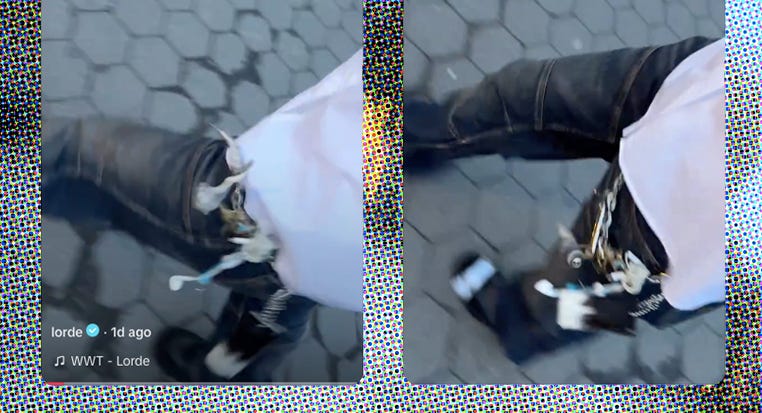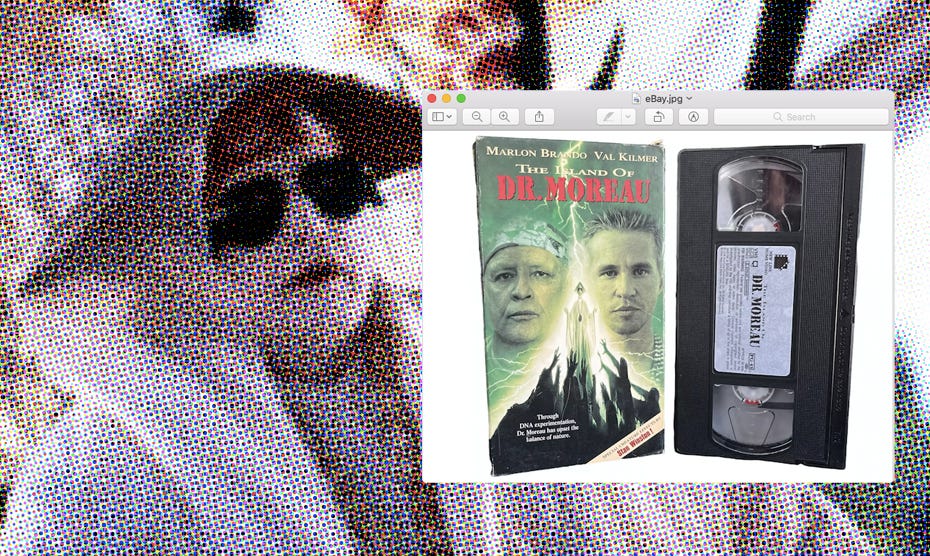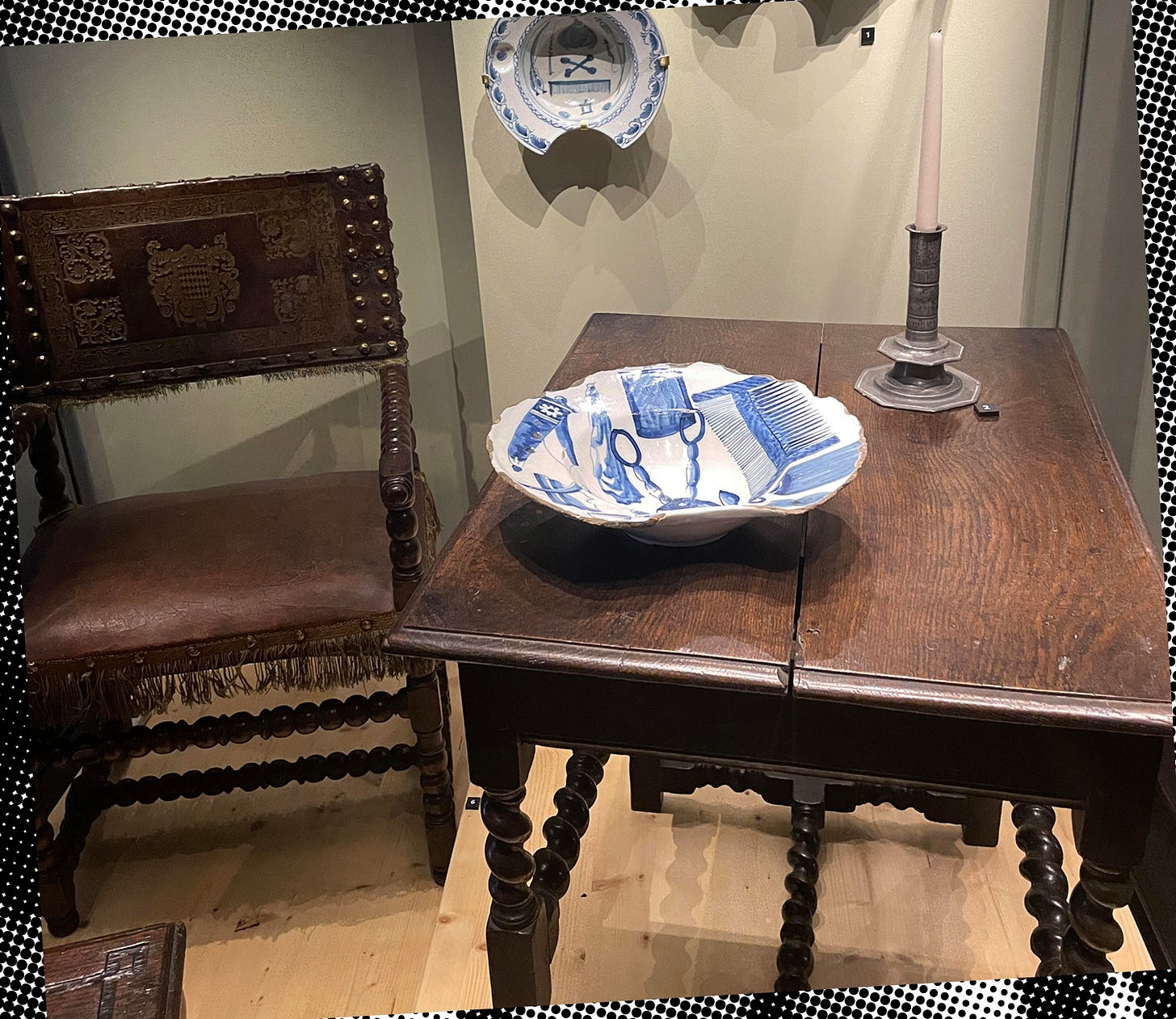If ASMR’s your thing then I have the skirt for you
A sensory edition that goes from haute to horror.
Crust is a weekly newsletter on taste and culture from Tāmaki Makaurau.
This week we’re traversing the sensory experiences of a fabulously noisy skirt, a harrowing film that you should hear and see, the eerie appeal of Sky World, a bloody visit to Auckland Museum, and the album I can’t stop playing right now (it’s Te Whare Tīwekaweka).
“That’s a bit loud.” Some people love to say it, that all-too familiar comment, and it’s usually derisive, passing judgment on a bit of brash and flash. Bright colours have a long history as a means to make an impact, stand out and assert class or cultural difference (not to mention lift the mood) but loudness can be taken literally too. There are sensory tactics other than sight that can be deployed to command attention. Consider sound; there’s a confidence and crazed charm to noisy clothes — they’re good for making your presence known — and pleasure for the wearer too, if you’re that way inclined.
I spent a good 10 minutes striding, lunging and jumping in the Penny Sage studio last Friday afternoon to see what movement could elicit the most satisfying rustle from their new ‘Passenger’ skirt, one for the stimmers among us. It’s generous, full and long, and also a very Auckland shade of grey (you know the one I mean) which, in the right material, can be rather evocative.
Penny Sage designer Kate Megaw is drawn to greys that have a bit of warmth in them. “This one is almost iridescent — you can’t quite pin down what shade it is. It shifts depending on the light and environment, which gives it so much depth; it can be a bit frustrating when trying to photograph it, because it looks different in every shoot!” (I saw another good grey item this week, a slouchy leather Sukib bag at The Keep on Karangahape Road). That’s the beauty of interacting with clothes offline, you can touch things. And hear them. It’s rooted in a real-world physicality.
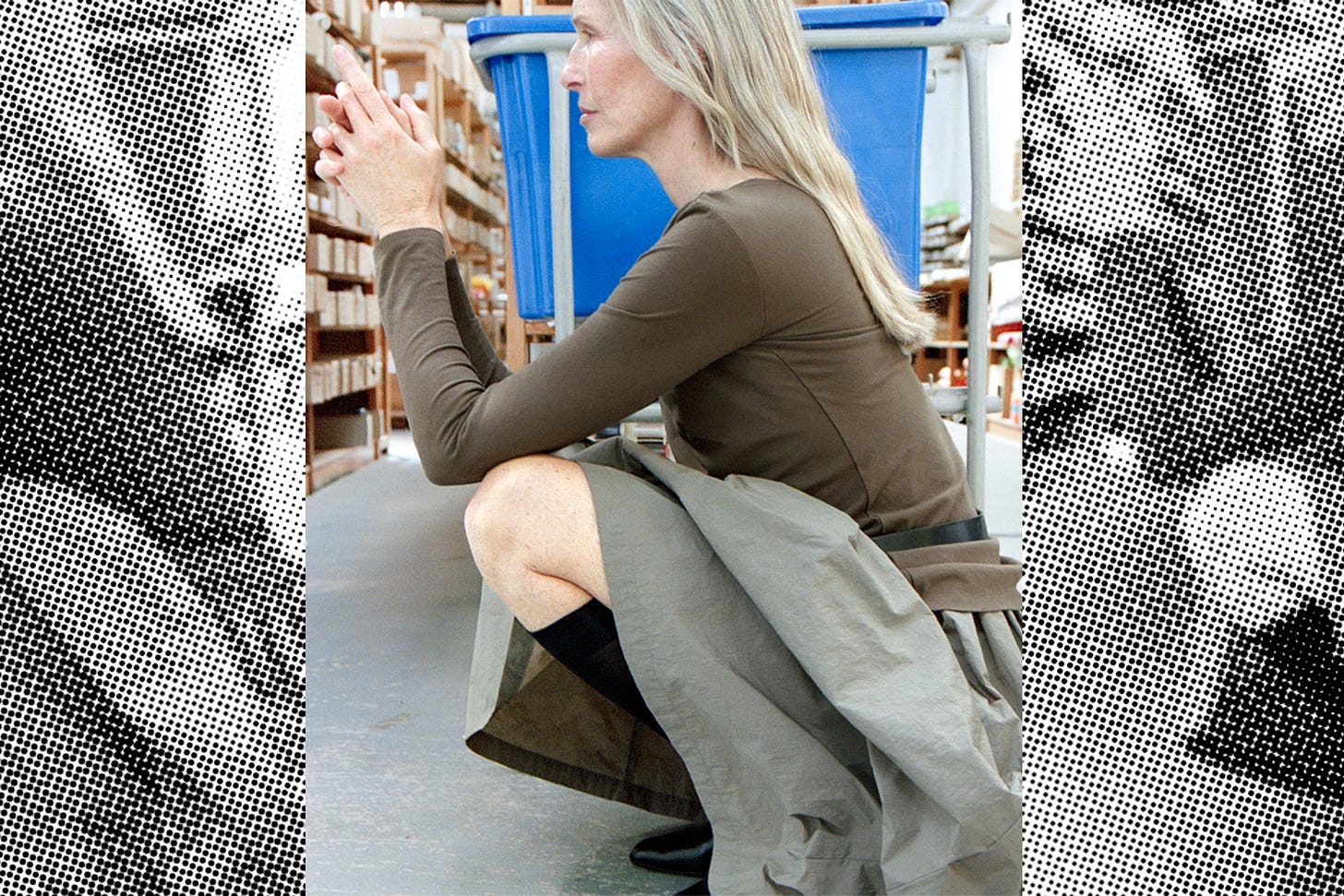
The new Penny Sage campaign also came out of an in-real-life experience, Kate’s visit to the brand’s long-time suppliers, the family-owned Arthur N Rowe on Taylors Road in Sandringham, who have been operating since 1923. “I always admire the space whenever I visit,” she tells me over email. “One day, while popping in with the winter campaign on my mind, I was unsure of where to shoot or who to ask to photograph it. Then I spotted one of their old '90s computers, seemingly out of use and immediately thought of Aileen Chen and how much she’d appreciate the scene. I sent her a few photos of the space and asked if she’d like to shoot there.”
They’ve been supportive of the brand since the beginning. “I remember spending hours there in the early days, sifting through old boxes of buttons and trims — it was a treasure trove. They still have some of those beautiful vintage boxes, with old logos and typefaces,” says Kate. “I love how there's always someone at these places who’s been there forever and has a photographic memory of every item — they can find exactly what you’re describing, even if you don’t know the name for it. These places are so special to our little industry, and now more than ever, it feels important to celebrate them.”
To achieve that skirt’s sound and colour, she used Japanese polyamide, sourced locally. “While I mostly work with natural fibres, I have a soft spot for technical fabrics like this one. They serve a different purpose and open up design possibilities that are different to naturals,” Kate explains. “This fabric has a kind of memory to it, when you scrunch it, it holds its shape. It makes a swishy, techy sound when you walk. I’m not into synthetics that try to mimic natural fibres, but I am drawn to technical ones like this that fully lean into their own qualities.” It’s also water resistant - good for Auckland weather.
For those who are curious, here’s some audio of me aggressively rustling said skirt in Kate’s fitting room:
Nice right? Synthetics can elicit some great sounds. I have some noisy hiking pants — which, given contextualisation, sound far more annoying when not on a trail. And then there are materials like corduroy (a good wale goes vvvrrrttt) and creaky leather jackets. If you’re particularly tuned in, you may be able to recognise someone you know well by the sound of their outfit. Like a cat with a bell, I can locate my husband by his jangling wallet chain. (Lorde wears a tchotchke-laden one in her latest album teaser, and no doubt fans will analyse the semiotics of each adornment as fervently as they did with her book stack and use of Unicode characters, while the rest of us wait to be blessed with the long-rumoured new album).
The only way to hear clothes is to be listening, so take those earbuds out occasionally. And then there’s shoes. In the sea of sneakers, the clack of a heel is enough to turn heads, and this relic is undergoing a revival. I’ve seen some fabulously bitchy heels on girls around town; it feels reactionary and looks hot. I love the thwack of a red band against a calf, and nothing says holiday like the fwopp of Havaianas under your heel. Boots, the kind you can buy at army surplus stores, have a distinctive footstep and sometimes, depending on the style and how you lace them, a quiet groan to the leather (what have they seen?). Depending on your reference points, personal canon and background — or baggage — the effect is wide-ranging.
Speaking of boots on the ground, this is my inelegant segue into the other thing occupying my mind this week: Alex Garland’s new film Warfare.
I saw it at the cinemas in the magnificent, dystopian Sky World. One of the coolest buildings in the central city (is its eerie desertion part of the fun?) it’s among my top five places to go see a movie. Others include The Academy, Hollywood Avondale and Rialto Newmarket, which might be the only Auckland cinema that boasts an external balcony.
Expecting dystopia from Warfare — because it’s Alex, and because really, I think all war films are dystopian regardless of intent — we debated that during the walk there. Anti-war films vs jingoist movies, and whether audiences enjoying the latter and rooting for victory is the most dystopian thing of all. After all, conflict is perhaps the ultimate and oldest spectacle, and spectacle is what defines our current age. Are you not entertained?
Warfare is co-written and co-directed with Ray Mendoza, a veteran of the Iraq war, and what they’ve made is a nightmare encased in memory and military jargon. It’s very good, but people are going to be upset by this film. You should see it at the cinemas; the sound is incredible, and you won’t scroll your phone during the (critical) bits of tension-building tedium. I recommend going in blind, because really that’s the only way to watch films these days. If that is indeed your plan, as it should be, then skip the next paragraph.
Over a brisk 90 minutes — truly rare these days — it details a really bad day at work for a group of strapping young Navy SEALs during the Iraq War. Seen through their experience, the job of war veers from boring to horrific. The plot, while ostensibly true, is presented as a memory. It’s a framing that’s drawn criticism, but I feel like there’s something to it. Memories are fallible, and with them our lived realities, and inherently devoid of an oppositional version of events. This also means Iraqis play a supporting role; they’re mise en scène, dehumanised and expendable throughout the film — save for telling sets, neighbourhood normality in the scope of a sniper rifle, and a haunting end scene — in the way they were for the war and the myth-building media around it. Warfare’s US troops are barely more humanised. We’re given no backstories, no character arcs, no personal information. No before and no after. They’re expendable too. I didn’t see any of them as heroes. Men (boys really) loaded up with gear, all the requisite military accoutrements, they follow the callous conventions of their jobs — invasive action in a suburban neighbourhood, taking over a family’s home — and it all blows up quite literally and then they leave.
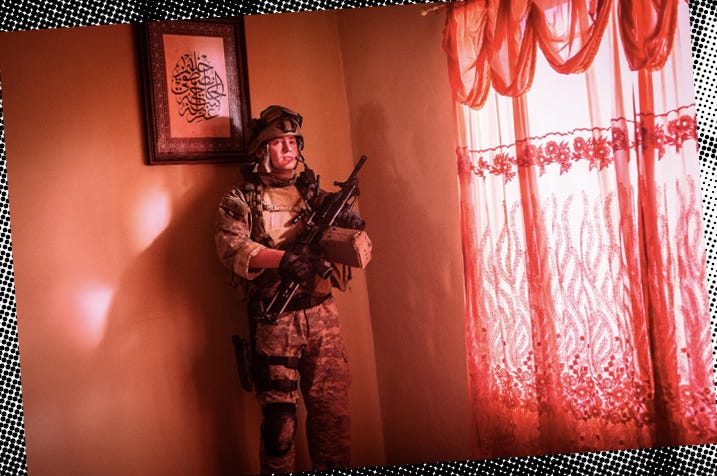
Alex has been explicit that this is an antiwar film, and you’d have to be particularly indoctrinated or obtuse to see it otherwise. There’s the literal horror sure, but also the sanitisation of violence via dense military jargon, surveillance technology, and the rote tedium of admin and logistics. Ray has said that if you watch it and think war is awesome “there’s probably something wrong with you”.
Some will of course. Hollywood is firmly established as a thrusting, handsome arm of the military-entertainment complex; the US Defense Department has collaborated with filmmakers for decades — and it’s no secret. The reviews and debates over Warfare are worth reading (some more sophisticated than others) and worth having. Is now the right climate for a war film, especially one about Iraq? It’s certainly not alone in the genre. There’s Masters of the Air and The Six Triple Eight; the Brits made Rogue Heroes and Blitz; and The Narrow Road to the Deep North is out soon. But I don’t want to get in the weeds here — this is meant to be a fun, breezy newsletter — so maybe a discussion about militarism on film is something for another time and medium (would you be interested? Tell me). There won’t be a shared consensus on Warfare, which is a good thing — films should get people talking — and a peek at the Letterboxd comments reveals deeply drawn trenches of opinion though the film hasn’t even hit cinemas yet, that happens on April 17.
To see Warfare for what it is we should place it next to the rest of Alex’s work and treat them as a collective canon. I still think Civil War was one of the best films last year (certainly underappreciated and mismarketed) and given the state of things everywhere it warrants a watch. We can see the ideas he’s grappling with in each book or film, no matter how different the subject matter, backpackers or zombies. Right from the start — The Beach was published in 1996, making him a Gen-X Wonderkind with a bestseller on shelves at the airports that traffic in the very kind of tourist he satirised — he’s shown an obsession with understanding what drives normal people to do terrible things. Societal disintegration, how we commit all those acts of violence and justify them, and the media lens through which we view them. It’s telling that he’s brought up the Yugoslav Wars and the trauma of “factional disintegration” during interviews since the beginning of his career.
I re-read The Beach this past summer and it hit way harder than the first time around, when I was a teenager. If you read it and see it as a fun jaunt with a bit of action then read it again. It’s an Edenic island commune with the kind of tourists who call themselves travellers, but it’s really about Western individualism, social hierarchies and the depraved nature of the human condition. All with palm trees and, for the film, Leonardo DiCaprio at the peak of his cultural power, all tanned and boyishly charming, far from the Richard of the book.
Will the surge of tourism Thailand experienced after Danny Boyle’s film (a truly poetic irony) be replicated by fans of The White Lotus, or was there too much bokeh in the latest season? Flights are cheap-ish right now — some can be found for around $1000 return — in case you’re interested. I am. Bangkok is one my favourite cities, and Auckland is getting cold.
On the topic of tropical boltholes, with all that’s in the water right now (and the death of Val Kilmer) it felt like an apt time to rewatch The Island of Dr. Moreau, a sprawling, chaotic and very 1990s Hollywood production about eugenics and oppression, subjugation and the social contract, sins of the father and the beast within. And Brando.
If you think that sounds like a lot, then watch the 2014 documentary about its notoriously disastrous production, Lost Soul: The Doomed Journey of Richard Stanley's Island of Dr. Moreau, which includes irradiated Sufi warlocks, hurricanes and great sunglasses. I want to see a new adaptation of the H. G. Wells’ 1896 book by someone like Robert Eggers, committing to its original setting of the late 19th century — a period that was famously humane and chill for everyone.
Speaking of creepy things in formaldehyde, if that’s your thing then stop by the ‘Bloodsuckers’ exhibition at Auckland Museum while it’s still there (it ends April 27). Amidst learning about some new things — how lampreys and mosquitos feed, the symbology of butterflies in vampire folklore — I did not expect the bloodletting apparatus in the show to be so chic, and the Delftware leech urns and bleeding bowls are quite novel.
This week I’ve been:
Listening… to Marlon Williams’ new album, Te Whare Tīwekaweka, which is sublime (particularly in the morning). I’ve been playing it more or less non-stop. It’s uplifting in its warmth and nostalgia, and the whole record is steeped in sentimentality. His famous voice is there of course, but so too are vocal harmonies that bring a deeply moving sense of “we” to the whole record.
Wondering… how Trump’s tariffs affect New Zealand fashion brands, and how freaked out do we actually need to be anyway? We’ve seen the memes, and the headlines. We’re in the grips of a trade war! Global markets are in meltdown! Trump targets island of penguins! So Ensemble asked me to talk to some economic experts and industry insiders to tell us how they feel, and what can be done to quell the spiralling and doomscrolls. Read it here, I even made a shoddy meme of my own.
Talking to… Emilia Wickstead about her new uniforms for Air New Zealand for RNZ (I think they’re fabulous, particularly the double-breasted jacket and ie faitaga).
Reading… Sightseeing. Self-aware, satirically fluent fans of The White Lotus and The Beach should read this brilliant book by Rattawut Lapcharoensap.
Speaking of satire, I’ve been thinking… that someone should make a satirical comedy series set in the Beehive — Veep meets The Educators. Can you imagine? I can. Someone call Jackie van Beek.
Watching… The Studio. Hats must go off to the set and wardrobe departments for the old-Hollywood references; it all feels very out-of-time, until you see an over-accessorised Kathryn Hahn clutching a Stanley cup. The series also does a masterful job of showing, and moving through, space — interesting when you compare it to the criticism that’s been rightly levelled at the claustrophobia of The White Lotus.
Deciding… what to see at the Auckland Writers Festival. There’s a lot on (thank god the programme has an index, everything should) and I’m enjoying a freelance income now, but one thing I won’t be missing is Writing Auckland on May 18, which sees Jeremy talk to Dominic, Alex and Shilo — authors of 1985, Episodes and All That We Know, respectively — about fictionalising this gorgeous, messy city of ours.
Enjoying… our shared appreciation for Curlz MT. There have been a few people sliding into my inbox about my font choice since the first edition of Crust was dispatched last Friday, and popping up on my feed this week was Constance’s ode to the typeface for Polyester Zine. Something in the water? Or simply a milestone anniversary (30 years).



